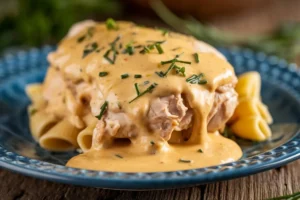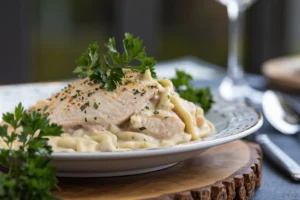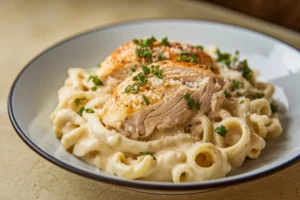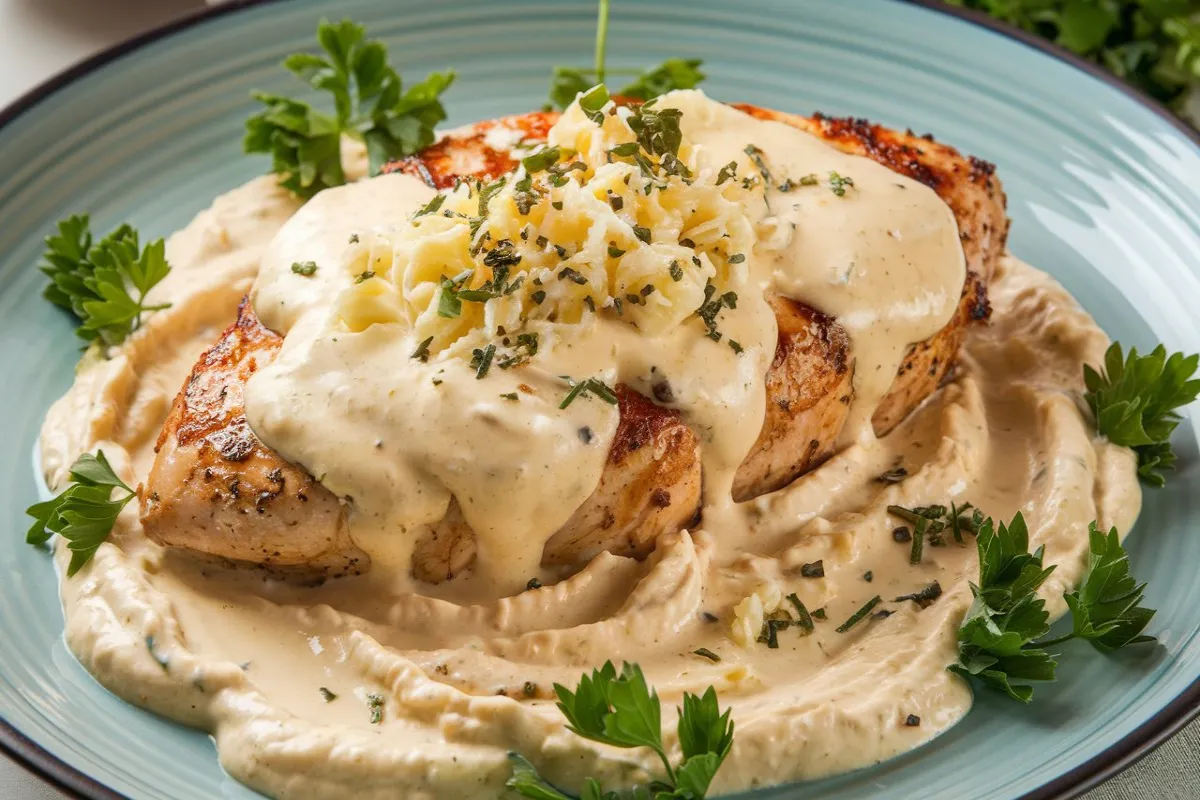Chicken Alfredo is a popular dish cherished for its rich and savory flavors. At its heart is Alfredo sauce, which transforms simple ingredients into a comforting meal. Whether served over fettuccine or other pasta, this sauce is a favorite in many kitchens. This guide dives into the key components of Chicken Alfredo sauce, variations, and tips to make it perfect at home.
What is Alfredo Sauce?
Alfredo sauce originated in Italy as a simple blend of butter and Parmesan cheese, traditionally served with fettuccine pasta. Italian restaurateur Alfredo di Lelio created the classic version, which later evolved in the U.S. to include heavy cream, making it richer and creamier. Today, Alfredo sauce pairs beautifully with proteins like chicken, shrimp, or vegetables, creating versatile dishes such as Chicken Alfredo. You can explore how the traditional and modern versions differ on The Spruce Eats.
Core Ingredients of Chicken Alfredo Sauce
To make Chicken Alfredo sauce, gather these essential ingredients:
- Butter: Butter serves as the base, creating a rich and smooth texture that binds the other ingredients.
- Heavy Cream: Heavy cream adds thickness and a velvety texture. While some recipes use half-and-half or milk, heavy cream provides the best consistency.
- Parmesan Cheese: Parmesan cheese brings a nutty, salty flavor, defining the sauce. Freshly grated Parmesan melts smoothly and prevents graininess.
- Garlic: Minced garlic enhances the overall flavor with a mild aromatic kick.
- Seasonings: Salt, pepper, and sometimes Italian seasoning balance the flavors, making the sauce savory and delicious.
For more tips on using fresh ingredients and achieving the perfect texture, check out the expert advice on Serious Eats.
Additional Ingredients and Variations

While the basic ingredients form the foundation, you can customize the sauce with a few variations:
- Cream Cheese: This addition thickens the sauce and adds a slight tangy flavor, commonly found in American variations.
- Lemon Juice: A bit of lemon juice brightens the sauce and adds a touch of acidity, cutting through the creaminess.
- Nutmeg: A pinch of nutmeg enhances the richness and adds a hint of warmth, often found in cream-based sauces.
- Flour: You can use flour as a thickening agent if you prefer a very thick sauce.
- Substitutes for Heavy Cream: For a lighter version, swap heavy cream with milk, half-and-half, or evaporated milk. Although these options create a thinner sauce, they maintain creaminess when combined with flour or cornstarch.
How to Make Chicken Alfredo Sauce from Scratch
Follow these steps to make your own Chicken Alfredo sauce:
- Melt the Butter: Heat butter in a large skillet over medium heat until it melts completely.
- Add Garlic: Stir in minced garlic and cook for about a minute until fragrant.
- Pour in Heavy Cream: Gradually add heavy cream while stirring. Keep the sauce at a gentle simmer without letting it boil.
- Add Parmesan Cheese: Slowly incorporate freshly grated Parmesan cheese in small batches, stirring until fully melted. This method helps avoid grainy sauce.
- Season: Add salt, pepper, and other seasonings as desired. Italian herbs or a dash of red pepper flakes can add extra flavor.
- Combine with Pasta and Chicken: Toss the sauce with cooked pasta and slices of grilled or sautéed chicken. Garnish with extra Parmesan and parsley for a complete dish.
Common Mistakes and How to Avoid Them
Creating the perfect Alfredo sauce requires some care. Here are tips to avoid common mistakes:
- Grainy Texture: Cheese added too quickly or at high heat often causes a grainy texture. Keep the heat low and add cheese slowly, allowing it to melt fully before adding more.
- Sauce Separation: High heat can cause butter to separate from the cream, leading to an oily sauce. Stir frequently and keep the heat moderate to low.
- Adjusting Thickness: If your sauce is too thick, thin it with milk, cream, or pasta water. To thicken, simmer longer or add a bit of flour or cornstarch.
Serving Suggestions
Here are some great serving suggestions for Chicken Alfredo that will elevate your meal and enhance the dining experience:
- Pair with a Fresh Salad: A simple green salad with a light vinaigrette provides a refreshing contrast to the rich Alfredo sauce. Caesar salad is also a classic choice, adding a hint of tanginess that balances the creamy pasta.
- Add Vegetables: Boost the nutritional value and add vibrant color by incorporating roasted or sautéed vegetables like broccoli, asparagus, spinach, or bell peppers. You can mix them into the pasta or serve them on the side.
- Serve with Garlic Bread: Garlic bread or breadsticks are perfect accompaniments that help soak up the creamy sauce. The crispy texture of the bread contrasts nicely with the smooth Alfredo sauce, making it a favorite side.
- Top with Grilled Proteins: In addition to chicken, you can top Alfredo with grilled shrimp, seared scallops, or crispy bacon for extra flavor and variety. These proteins complement the sauce without overwhelming the dish.
- Finish with a Lemon Twist: A squeeze of fresh lemon juice just before serving can brighten the dish and cut through the richness, giving it a fresh, vibrant taste.
- Add Fresh Herbs: Garnishing with fresh herbs like parsley, basil, or chives not only adds a pop of color but also enhances the flavor. Herbs provide a fresh note that balances the creamy Alfredo sauce.
- Pair with Wine: Chicken Alfredo pairs well with a crisp white wine like Chardonnay, Pinot Grigio, or Sauvignon Blanc. These wines complement the creamy texture and enhance the overall dining experience.
- Complement with Light Appetizers: Start the meal with light appetizers like bruschetta, antipasto, or a light soup. This keeps the focus on the Alfredo without overwhelming the palate.
Tips for Serving
Nutritional Information

Due to its cream and cheese content, Alfredo sauce is high in fat and calories. A serving of Chicken Alfredo typically ranges from 800 to 1,000 calories. Here’s a quick breakdown of the nutritional values:
- Calories: Around 919 kcal per serving
- Fat: 65 g (including 37 g saturated fat)
- Protein: 39 g
- Carbohydrates: 45 g
To reduce calories, consider using lower-fat dairy or reducing the amount of butter and cheese. For more nutritional details and lighter variations, visit Healthline.
FAQs About Alfredo Sauce
Can you use milk instead of heavy cream?
Yes, milk works as a substitute but will create a less rich sauce. To maintain creaminess, consider adding flour or cornstarch as a thickener.
How do you store and reheat Alfredo sauce?
Store Alfredo sauce in an airtight container in the refrigerator for up to five days. Reheat slowly on the stovetop, stirring often to prevent separation. Avoid microwaving, as it can make the sauce oily.
Why did my Alfredo sauce turn out too thick?
If the sauce is too thick, thin it with a bit of milk, heavy cream, or chicken broth. Stir gradually until it reaches the desired consistency.
Can I make Alfredo sauce ahead of time?
Yes, you can make the sauce ahead and refrigerate it. The sauce may thicken when cooled, so thin it slightly when reheating.
Is Alfredo sauce gluten-free?
Traditional Alfredo made with butter, cream, and cheese is naturally gluten-free. If you use flour, make sure it’s gluten-free to suit dietary restrictions.

Conclusion
Chicken Alfredo combines simple, high-quality ingredients into a comforting, restaurant-quality meal. By mastering the basics of Alfredo sauce and experimenting with variations, you can create a dish that suits your taste. Enjoy it traditionally over pasta or explore new ways to serve it. Whether making it from scratch or trying out creative variations, Alfredo sauce brings rich, savory flavors to your table. For more tips and expert advice, check out resources like Serious Eats to refine your Alfredo sauce-making skills.

